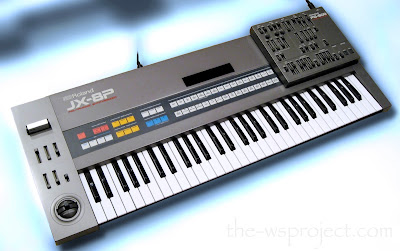ROLAND JX-8P + PG-800
 |
| Analog 6-voice DCO Polyphonic Synthesizer - Released in 1984 |
In the 80′s digital was coming big time and that naturally affected synths as well, not always in a good way. One downside of this new digital technology was that the synths' programming interfaces were cut down significantly. The old analog synths had a dedicated knob, switch or slider etc. for just about every parameter in the synth, but a typical digital interface was a couple of buttons that called up one parameter at a time for adjusting it, and the whole instrument was operated from a tiny LCD display. This might have been cost saving, but programming a synth like that became tedious and uninspiring. A positive feature of digitality was the possibility to store sounds.
The JX-8P suffers also this very boring digital user interface. But fortunately Roland made a separate programmer unit for it, the PG-800! The programmer is quite an essential if you really wish to dive into the synthesis of JX-8P (or JX-10).
 |
| JX-8P with a PG-800 Synthesizer Programmer |
The sound of JX-series is a bit different from the popular Juno-series. But the JX-8P offers a lot more programmability of sounds with it’s dual oscillators. Roland was advertising it being able to deliver "rich-timbred patches usually associated only with digital synthesis" along with classic analog sounds. And that’s kind of true with functions like waveform cross-modulation and oscillator sync for example. But the synth is really excellent with classic analog sounds like string pads and brass sounds. The JX-8P has also a very fat and warm-sounding stereo chorus.
 |
| Memory cartridge to store more sounds. |
The JX-8P is a very nice and smooth analog polysynth although a bit ugly in my opinion, (the JX-3P looks better). It can be had pretty cheap but the PG-800 programmer is usually raising the value considerably.
Soon after I realized how wonderful my first analog synth, the Yamaha SK-20 sounded, I wanted to get more involved with analog synths. My next purchase was this JX-8P. It sounded excellent but very different from the SK-20. I used it a lot on the albums Enlightenment, Subtle Moves and Orion.
 |
| Now you can control the synth! |
 |
| Roland JX-8P under a Micromoog. |



